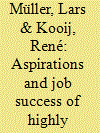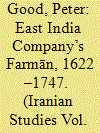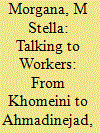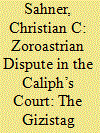|
|
|
Sort Order |
|
|
|
Items / Page
|
|
|
|
|
|
|
| Srl | Item |
| 1 |
ID:
165774


|
|
|
|
|
| Summary/Abstract |
This study pioneers the quantitative research of second generation Iranian graduates in Germany. Second generation immigrants in Germany, immigrants raised in Germany with at least one parent born abroad, are relevant as they are a crucial part of German society. Second generation immigrants in general as well as Iranians in particular are assumed to have high extrinsic aspirations. But a dataset big enough to study the employment situation of second generation Iranian graduates in Germany did not exist. Therefore, the article uses the KOAB dataset from 2011 to 2015, which contains data from 53,429 full-time employed higher education graduates in Germany (among those are 161 second generation Iranians). Their extrinsic job aspirations and career success (income, job satisfaction) are analyzed. Multivariate analyses reveal the higher extrinsic job aspirations of second generation Iranian graduates compared to many other migrant groups and Germans but similar to second generation Turkish graduates. Nevertheless, the extrinsic job aspiration is relevant, though only one factor among others to predict career success.
|
|
|
|
|
|
|
|
|
|
|
|
|
|
|
|
| 2 |
ID:
165776


|
|
|
|
|
| Summary/Abstract |
There have been a number of important efforts to map out the languages of Iran, but until now no language atlas, or even a comprehensive and detailed country-level language map, has been produced. One of the recent initiatives which aims to fill this gap is the online Atlas of the Languages of Iran (ALI) (http://iranatlas.net). This article delineates objectives of the ALI research programme, atlas architecture, research methodology, and preliminary results that have been generated. Specific topics of interest are the structure and content of the linguistic data questionnaire; the handling of contrasting perspectives about the status of “languages” and “dialects” through a flexible multi-dimensional classification web; and the role of ongoing comparisons between language distribution assessments and hard linguistic data.
|
|
|
|
|
|
|
|
|
|
|
|
|
|
|
|
| 3 |
ID:
165772


|
|
|
|
|
| Summary/Abstract |
This paper argues that the mature form of the political doctrine of the Ayatollah Khomeini (1902–89), Iranian Shiite religious authority and architect of the Islamic Republic of Iran, grew out of an encounter with the modern understanding of the state and the concept of sovereignty. Khomeini’s political doctrine, called the Absolute Guardianship of the Islamic Jurist, although based on a religious foundation, should be studied as a break with the traditional understanding of political power in Shiism. It will be argued that such a political doctrine can play the same role as the Christian rhetoric of the early modern political thinkers played, pave the way for modernization of Shiite political thought, and prepare the ground for a modern temporal conception of politics.
|
|
|
|
|
|
|
|
|
|
|
|
|
|
|
|
| 4 |
ID:
165769


|
|
|
|
|
| Summary/Abstract |
About 150 years ago, after Avestan researchers such as Jackson, Browne, and Westergaard had unsuccessfully attempted to discover new manuscripts in Iran, it was assumed that there were few or no Avestan manuscripts remaining in Iran. However, recent research and fieldwork in Iran have resulted in important findings disproving this assumption. Since 2011, more than eighty-five Avestan manuscripts have been discovered in Iran. One of these important discoveries has been Pouladi’s Collection, which was found in February 2016 in a Zoroastrian house in the Priests’ Quarter (Mahalle-ye Dastūrān) in Yazd. This article deals with the secondary life of Avestan manuscripts of Pouladi’s Collection, focusing on colophons and marginal notes.
|
|
|
|
|
|
|
|
|
|
|
|
|
|
|
|
| 5 |
ID:
165775


|
|
|
|
|
| Summary/Abstract |
The East India Company’s presence and ongoing trade in Persia was reliant on the privileges outlined in the Farmān, granted after the capture of Hormuz in 1622. The relationship between these two powers was cemented in the rights enshrined in the Farmān, which was used by both to regulate their varying needs and expectations over the course of 125 years. This article explores the Company’s records of the Farmān and how changes to its terms were viewed from both sides. As a Persian document, the Farmān gives a clear view of the attitudes of native officials and rulers to the Company and how these terms were used as a means of control.
|
|
|
|
|
|
|
|
|
|
|
|
|
|
|
|
| 6 |
ID:
165771


|
|
|
|
|
| Summary/Abstract |
This paper examines the Pahlavi National Library, the planning for which began in 1972 and expired in 1978 on the eve of the Islamic Revolution. The Pahlavi National Library was to rank in size and eminence with the great libraries of the world, yet this extraordinary project has hitherto received little to no scholarly attention. Using documents primarily from the archives of the shah’s cultural counsellor at the imperial court, Shojāʿeddin Shafā, this paper looks in detail at a number of initiatives spearheaded by Shafā from the early 1960s, which essentially laid the groundwork for the Pahlavi National Library, in order to understand how the shah’s regime used culture and scholarship to further its political goals. The paper proceeds to investigate the Pahlavi National Library, analyzing it in the context of the shah’s domestic and foreign policy objectives.
|
|
|
|
|
|
|
|
|
|
|
|
|
|
|
|
| 7 |
ID:
165773


|
|
|
|
|
| Summary/Abstract |
This paper explores the transformations of the Islamic Republic of Iran’s dominant narratives on labor between 1979 and 2009. By analyzing official May Day speeches of this period, it navigates multiple constructions of workers’ roles, which were systematically propagated by the IRI’s Supreme Leader and president over time. The analysis relies on the following primary sources: from the 1979 May Day sermon, pronounced by Ruhollah Khomeini, to the 2009 speech given by Mahmoud Ahmadinejad, together with messages sent by Ali Khamenei, Hashemi Rafsanjani and Mohammad Khatami. Showing how workers’ role—understood as a collective and distinct group—was gradually minimized, this paper argues that a bottom-up cleaning up process slowly purified May Day. In fact, the IRI progressively neglected workers as (revolutionary) social actors and interlocutors, as it stopped talking to masses and started speaking to middle classes.
|
|
|
|
|
|
|
|
|
|
|
|
|
|
|
|
| 8 |
ID:
165770


|
|
|
|
|
| Summary/Abstract |
The Gizistag Abāliš is a ninth- or tenth-century Pahlavi text, recording a debate which took place at the court of al-Maʾmūn between a Zoroastrian priest and a heretical dualist. This article, the first in-depth study of this important work, examines the text in its broader Islamicate environment. It argues that the narrative itself is probably fictional, but reflects a real historical phenomenon, namely the interreligious debates which took place among Zoroastrians, Muslims, Christians, and Jews during the ʿAbbasid period. It argues that the text is a unique Zoroastrian example of a literary genre that was common among Christians at the time, namely, “the monk in the emir’s majlis.” By comparing the Gizistag Abāliš to these Christian texts, it explores why Zoroastrians generally did not launch explicit polemics against Islam, comparable to those of other non-Muslim communities. It seems that Zoroastrian authors were more concerned with explaining their own doctrines than critiquing the beliefs of others. This is curious considering the large numbers of Zoroastrians who were converting to Islam at the time. Finally, the article proposes new ways of refining the way we read Pahlavi texts, by analyzing them alongside the literatures of other religious communities in the early Islamic empire.
|
|
|
|
|
|
|
|
|
|
|
|
|
|
|
|
|
|
|
|
|